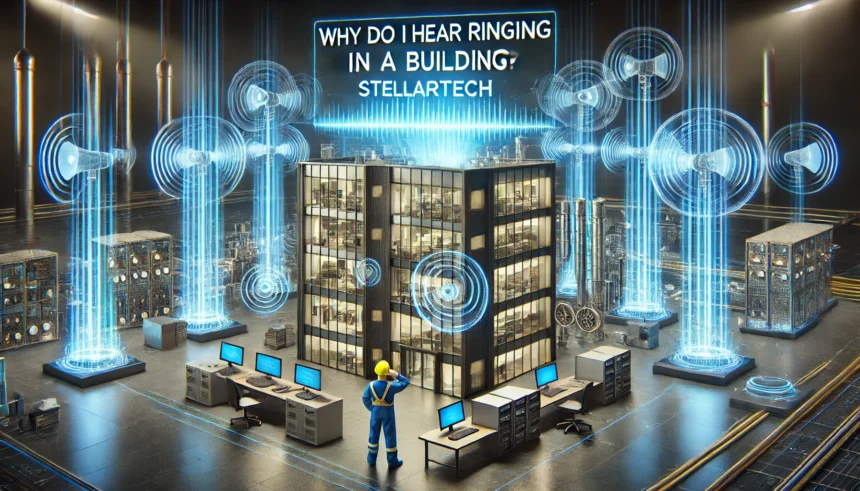Hearing a constant ringing sound inside a building can be both distracting and frustrating. This issue is commonly experienced in modern buildings, and in the case of why do I hear ringing in a building Stellartech, multiple electronic devices, structural designs, and mechanical systems contribute to sound interference.
At Stellartech, where high-tech equipment is used extensively, these sounds can originate from various sources. Understanding the reasons behind this phenomenon can help in identifying and resolving the issue effectively.
Many factors, such as HVAC systems, electrical components, and architectural materials, can produce ringing noises. Sometimes, the sound is subtle, while at other times, it may be more noticeable depending on the surroundings.
Identifying the exact source of the ringing sound is essential. Proper maintenance, acoustic improvements, and noise isolation can help eliminate unwanted noise inside a building.
Common Causes of Ringing Sounds in Buildings
HVAC Systems (Heating, Ventilation, and Air Conditioning)
HVAC systems are one of the most common sources of noise in buildings. Airflow moving through vents and ducts can create high-frequency sounds, which may resemble ringing or buzzing.
Faulty components, such as loose fan blades, worn-out compressors, or misaligned ducts, can generate vibrations. These vibrations may travel through the building, amplifying the noise.
Regular maintenance of HVAC units is crucial. If filters are clogged or air pressure is uneven, it can cause whistling or high-pitched humming sounds.
If the noise persists, sound-dampening materials inside vents and around HVAC units can help absorb excess noise. Proper insulation also minimizes unwanted vibrations.
Electrical Systems and Wiring
Electrical wiring inside a building can be another potential cause of ringing sounds. Loose electrical connections or high-voltage circuits often emit a faint buzzing or ringing noise.
Fluorescent lights, LED drivers, and transformers sometimes create a persistent hum due to their electromagnetic frequency. This is particularly noticeable in high-tech environments like Stellartech.
Overloaded circuits and power fluctuations can also produce noise. A faulty power supply or improperly grounded wiring may cause electronic interference, resulting in a subtle ringing sound.
To prevent this issue, regular inspection of electrical wiring and grounding systems is necessary. Upgrading to noiseless electrical components can also help reduce background noise.
Structural and Architectural Factors
The materials used in a building’s construction can influence sound distribution. Metal beams, pipes, and large glass panels may resonate with certain frequencies, causing a ringing sensation.
Large open spaces or long corridors can amplify noise. If a sound wave is trapped between hard surfaces, it may create an echoing effect that makes the ringing sound more pronounced.
Thin walls and poorly insulated ceilings may also transmit vibrations from nearby machinery or external noise sources. This is common in modern office buildings with minimalistic designs.
To counteract these issues, using sound-absorbing materials such as carpets, acoustic panels, and insulated glass can help. These adjustments prevent excessive reverberation and minimize noise interference.
External Sources of Noise
Outside noise can sometimes enter a building, leading to a ringing or buzzing sensation. Traffic, construction work, and industrial equipment can contribute to background noise.
Cell phone towers and radio signals may also play a role. If electronic devices inside the building interact with external signals, they might emit a faint buzzing sound.
Wind and environmental conditions can create structural vibrations. In high-rise buildings, wind pressure against windows and metal frames might result in a subtle ringing sound.
Proper soundproofing solutions, such as sealing gaps around windows and using noise-blocking curtains, can help prevent external noise from entering the building.
Why This Issue is Common in Stellartech Buildings
High-Tech Equipment and Machinery
At Stellartech, the extensive use of advanced machinery and electronic devices increases the likelihood of sound interference. High-frequency testing equipment and sensitive instruments may generate background noise.
Computers, servers, and other digital devices can emit a low-level hum or ringing sound. This noise is often caused by power supplies and cooling fans running at high speeds.
Industrial-grade machinery used in research and development may also contribute to mechanical vibrations. These vibrations can travel through walls and floors, creating noticeable sound effects.
To minimize these disturbances, soundproofing server rooms and isolating heavy machinery in designated areas can help reduce unnecessary noise pollution.
Architectural Design and Acoustic Effects
Modern architectural designs used in Stellartech buildings may contribute to sound-related issues. Large glass windows and open spaces often allow sound waves to travel freely.
Metallic structures and reflective surfaces can enhance sound resonance. This can make certain frequencies, such as high-pitched ringing, more noticeable in specific areas of the building.
A comparison table below highlights how different building materials affect sound transmission:
| Material | Effect on Sound | Common Issue |
| Metal beams | Amplifies vibrations | Causes ringing or humming |
| Glass walls | Reflects sound waves | Increases echo effect |
| Open ceilings | Disperses noise unevenly | Causes background hum |
| Concrete walls | Blocks external noise | Reduces interference |
Using sound-absorbing materials such as soft wall panels and carpets can significantly improve acoustics. Strategic placement of partitions can also help manage sound waves within the building.
How to Identify the Source of the Ringing Sound
Step-by-Step Troubleshooting
Finding the exact cause of the ringing sound requires systematic troubleshooting. The first step is to walk around the building to identify where the noise is most noticeable.
Turning off different electrical devices and machines one by one can help pinpoint the source. If the noise disappears after turning off a specific device, that device is likely responsible for the sound.
Listening near air vents, electrical outlets, and mechanical equipment can provide clues. If the sound is louder in certain areas, it may indicate a problem with HVAC systems or electrical wiring.
Using sound detection tools, such as smartphone decibel meters, can help measure the frequency of the noise. Professional acoustic assessments can also provide a more precise analysis.
Solutions to Reduce or Eliminate Ringing Sounds
Routine Maintenance and Repairs
Regular maintenance of HVAC systems, electrical wiring, and machinery is essential. Fixing loose components and replacing worn-out parts can eliminate many sources of ringing noise.
Checking the building’s power supply and grounding system can prevent electrical humming. Upgrading older equipment to quieter, modern alternatives can also help.
Improving Acoustic Control
Adding sound-absorbing materials like rugs, curtains, and acoustic panels can help dampen noise. These materials prevent sound waves from bouncing around and amplifying certain frequencies.
Placing furniture and partitions strategically can break up sound waves. This is particularly useful in open office spaces where noise tends to travel freely.
Using Technological Solutions
Installing white noise machines can mask unwanted ringing sounds. These devices create a balanced sound environment, reducing the impact of high-pitched frequencies.
Applying vibration dampeners to HVAC systems and electrical panels can minimize mechanical noise. Advanced soundproofing solutions, such as insulated doors and double-glazed windows, can further enhance noise control.
Conclusion
Understanding why do I hear ringing in a building Stellartech requires looking at multiple factors. HVAC systems, electrical wiring, building materials, and external noise sources all play a role.
Since Stellartech uses high-tech equipment and modern architectural designs, noise interference is more likely. Identifying and addressing the sources of these sounds can greatly improve the work environment.
Implementing maintenance routines, acoustic adjustments, and noise-reducing technologies can help create a quieter and more comfortable space. A well-managed sound environment leads to better productivity and fewer distractions.
FAQs
Why do I hear ringing in a building Stellartech even when it’s quiet?
The noise may come from HVAC systems, electrical wiring, or building materials reflecting sound waves.
Can electronic devices cause a ringing sound in Stellartech buildings?
Yes, computers, transformers, and high-frequency testing equipment can emit subtle buzzing or ringing noises.
How can I tell if the ringing sound is from HVAC systems?
If the noise increases near vents or when the system turns on, it likely originates from HVAC components.
What materials in a building can amplify ringing noises?
Metal beams, glass panels, and open spaces can enhance sound resonance, making ringing noises more noticeable.
How can I reduce the ringing sound inside Stellartech buildings?
Regular maintenance, soundproofing materials, and vibration dampeners can help minimize noise interference.









